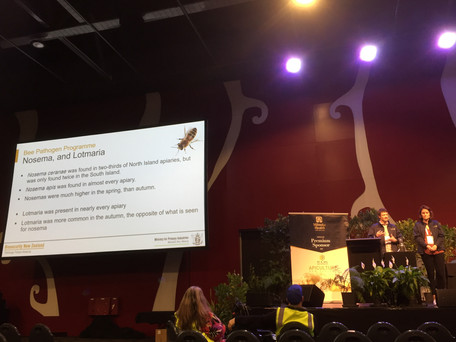Conference Takeaways
- Patrick Dawkins
- Jul 3, 2021
- 5 min read
With around 1000 delegates and 60 trade displays filling the Rotorua Energy Events Centre, the Apiculture New Zealand (ApiNZ) National Conference acted as a three day show of positivity for a struggling beekeeping industry, June 24-26.
At its peak the national conference drew closer to 1500 delegates, but, given the drop in non-manuka honey prices experienced over the past three years, this year’s turnout could be seen as a healthy one for ApiNZ. Chief executive Karin Kos agreed, saying she was pleased with the support given to the event by beekeepers.

Unlike two years ago, when the national conference was last held and the economics of the honey industry were the major talking point, conversations around bee health were increasingly prominent. That was perhaps unsurprising, given the event’s focus of Healthy Bees, Healthy Industry, Healthy Future, combined with recent struggles with varroa and hive losses in the area.
While the main stage saw attendees tune into video presentations from a range of keynote international speakers, as well as some local insight and updates from industry groups, some of the smaller seminar rooms allowed discussion on more specific issues, such as managing RMP facilities, practical beekeeping tips, creaming honey and mead making. Surrounding all of that was the regular flow of delegates through the trade displays, including the booth held by Apiarist’s Advocate, which couldn’t help noticing some key takeaways…
New Zealand Avocado chief executive Jen Scoular’s speaking slot on the first morning of the conference was titled “Unlocking an industry’s potential”, but might as well have been “The need for a commodity levy”. Scoular spent her time on stage detailing how avocados have gone from a $60million export industry in 2011 to $231million in the space of 10 years, since the introduction of a grower levy. In 2018 ApiNZ saw their proposed honey levy voted down by a significant margin, so the message in Rotorua was about as subtle as a sledgehammer as beekeepers in the audience turned avocado-green with envy seeing the results of the fruit growers’ investment.
Scoular declared that “in the short, medium and long term, avocado growers absolutely need bees”, while pointing out that avocado flowers have a 0.3% fruit set success, meaning there is plenty of scope for improved pollination.
Kos’ announcement that ApiNZ have been directed to form a Code of Welfare for bees had some beekeepers concerned about potential restrictions being put on their management practices. However, like with the manuka honey export standard, apiculture will have to jump at the request of MPI.
The message to control and monitor varroa mite came through loud and clear during several presentations and discussions, including from leading American honey bee scientist Dennis vanEngelsdorp who presented research that found varroa treatment and monitoring to be the top-ranking management criteria to determine colony health and mortality. “Mites matter. Monitor and treat them,” he stressed.
VanEngelsdorp’s use of a robbing screen which masked hive entrances and greatly reduced reinvasion of varroa had Kiwi beekeepers thinking how they could implement a similar system on their hives.
Canadian queen-bee researcher Patricia Wolf Veiga delivered what most beekeepers inherently know, but it is always good to be reminded of: “Do not overwinter weak hives. Miracles don’t happen in winter. You will suffer high hive losses.”
As Californian “scientific beekeeper” Randy Oliver dished out updates on trials of pollen supplements and organic varroa treatments, a couple of things stood out. While he expects oxalic acid to be a “game changer for the treatment of varroa” he noted it was a far more effective treatment at his site at higher altitude where there was no neighbouring hives to promote reinfestation. Unfortunately, many New Zealand beekeepers using a similar treatment regime are missing the, perhaps, vital component that the far reaches of the Sierra Nevada mountain range has provided.
Oliver’s breeding programme for varroa resistance is proving difficult to progress, with him hypothesising that drones could carry much of the relevant hereditary genetic material, thus slowing breeding advancements.
National manager Clifton King and the AFB Management Agency introduced what is expected to be at least a year-long consultation process as part of the 10-yearly review of the Pest Management Plan. King outlined the process clearly to the main auditorium and the Agency has since made the PDF version of the talk available on their website, set dates for webinars to detail the process on July 1, 5 & 8, emailed all registered beekeepers and sat down for an interview for page 18 of this publication – that’s effective communication.
Conversely, the Manuka Charitable Trust addressed the room through their chair Pita Tipene, via video-link, and Kristen Kohere-Soutar, the newly appointed executive chair of the Trust’s operating arm Te Pitau, who flatly admitted “we have work to do in our communications” before both exited without answering any questions from the hundreds of beekeepers in attendance.
On the issue of communication, MPI’s manager for operational research Claire McDonald stated the Ministry wanted to communicate effectively with beekeepers throughout their process of reviewing the manuka honey standard. Unlike the Manuka Charitable Trust, McDonald at least followed her claim by answering questions from the many beekeepers gathered, who unsurprisingly grilled the MPI representative by pointing out inadequacies in the manuka definition set in 2018, who replied “to date there has been no robust evidence to support a change to the definition”.
The MPI Pathogen Programme, which monitored selected apiaries across New Zealand every two and a half months for three years, has banked a “mountain of data” which made possible reports on the prevalence of many diseases of the hive. They included findings of Nosema ceranae in two South Island apiaries, along with two-thirds of all North Island apiaries. Nosema Apis was found in almost every apiary across the country.
The general discussion generated between Harry Woods of Manuka Health and James Annabell of Egmont Honey, which was well facilitated by 100% Pure New Zealand Honey CEO Sean Goodwin, provided an enlightening insight into the international honey trade, as seen through the eyes of some of New Zealand’s biggest packers. While both Woods and Annabell displayed the confidence in the industry that having tens of millions of dollars of annual honey export revenue will bring, those at the coal face of harvesting those honey crops will have benefitted from learning of the huge expense that comes with pushing into new markets, the length of that process, the dramatically increased cost of transporting goods in a Covid world, the challenge of balancing building a great brand with creating awareness of a product, how hard fought any price increase is in competitive market places, and that consumers care little about our export manuka honey standard and more about Codex definitions.
Otago beekeeper Allen McCaw’s quip from the audience, following the honey market discussion detailed above, sums up the trading position of New Zealand beekeepers battling a backlog of honey: “We’ve got a big advantage with honey, in that it keeps. We’ve got a big disadvantage with honey, in that it keeps.”
















コメント